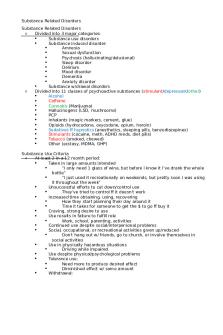1.2. Amount of Substance PDF

| Title | 1.2. Amount of Substance |
|---|---|
| Course | Introductory Chemistry |
| Institution | University of Manchester |
| Pages | 4 |
| File Size | 274 KB |
| File Type | |
| Total Downloads | 32 |
| Total Views | 161 |
Summary
a level summary notes for chemistry physical...
Description
AQA Chemistry A-Level 3.1.2: Amount of Substance Detailed Notes
3.1.2.1 - Mr and Ar Relative atomic mass (Ar) is defined as: The mean mass of an atom of an element, divided by one twelfth of the mean mass of an atom of the carbon-12 isotope. Relative molecular mass (M r) is defined as: The mean mass of a molecule of a compound, divided by one twelfth of the mean mass of an atom of the carbon-12 isotope. For ionic compounds, is it known as r elative formula mass.
3.1.2.2 - Moles and the Avogadro Constant The mole is a u nit of measurement for substances. It always contains the same number of particles.
This number is the A vogadro Constant (L) and allows the number of particles present in a sample of a substance with known mass to be found:
(n = moles)
(L = Avogadro constant)
The mole is a v ery important unit of measurement in many calculations:
(where concentration is in moldm-3)
3.1.2.3 - Ideal Gas Equation When under standard conditions, gases and volatile liquids follow certain trends: pressure is proportional to temperature volume is proportional to temperature pressure and volume are inversely proportional These relationships can be combined to give the ideal gas equation:
In order to use this equation, the variables must be in the correct standard units: p = pressure in Pascals V = volume in m3 T = temperature in Kelvin n = moles m = mass in grams R is the ideal gas constant, equal to 8.31 JK-1mol-1.
3.1.2.4 - Empirical and Molecular Formula Empirical formula is the s implest whole number ratio of atoms of each element in a compound. It is found using molar ratios of each element. (see model answer) Molecular formula is the t rue number of each atom in the molecule. It can be determined using the Mr of the empirical formula and the true Mr of the molecule. This give a multiplier value which can be used to scale up the empirical formula.
(see model answer)
3.1.2.5 - Equations and Calculations Chemical equations must be b alanced before they can be used in calculations. This is because the reacting ratios must be correct. It can then be used to calculate reacting masses, percentage yield and atom economy.
Percentage Yield
Atom Economy
In industrial chemical processes it is desirable to have a h igh atom economy for a reaction. This means there is little or no waste product, only the desired product. Therefore it means the process is more economically viable for industrial scale manufacture....
Similar Free PDFs

1.2. Amount of Substance
- 4 Pages

Wetting Property OF A Substance
- 7 Pages

Doctrine of Pith and Substance
- 4 Pages

Present Value of a Single Amount
- 2 Pages

Substance Abuse.Concept Map
- 1 Pages

Substance Related Disorders
- 9 Pages

Chapter 17 Substance Abuse
- 1 Pages

CH 6 Substance USE Assessment
- 6 Pages

real gas and pure substance
- 3 Pages
Popular Institutions
- Tinajero National High School - Annex
- Politeknik Caltex Riau
- Yokohama City University
- SGT University
- University of Al-Qadisiyah
- Divine Word College of Vigan
- Techniek College Rotterdam
- Universidade de Santiago
- Universiti Teknologi MARA Cawangan Johor Kampus Pasir Gudang
- Poltekkes Kemenkes Yogyakarta
- Baguio City National High School
- Colegio san marcos
- preparatoria uno
- Centro de Bachillerato Tecnológico Industrial y de Servicios No. 107
- Dalian Maritime University
- Quang Trung Secondary School
- Colegio Tecnológico en Informática
- Corporación Regional de Educación Superior
- Grupo CEDVA
- Dar Al Uloom University
- Centro de Estudios Preuniversitarios de la Universidad Nacional de Ingeniería
- 上智大学
- Aakash International School, Nuna Majara
- San Felipe Neri Catholic School
- Kang Chiao International School - New Taipei City
- Misamis Occidental National High School
- Institución Educativa Escuela Normal Juan Ladrilleros
- Kolehiyo ng Pantukan
- Batanes State College
- Instituto Continental
- Sekolah Menengah Kejuruan Kesehatan Kaltara (Tarakan)
- Colegio de La Inmaculada Concepcion - Cebu






